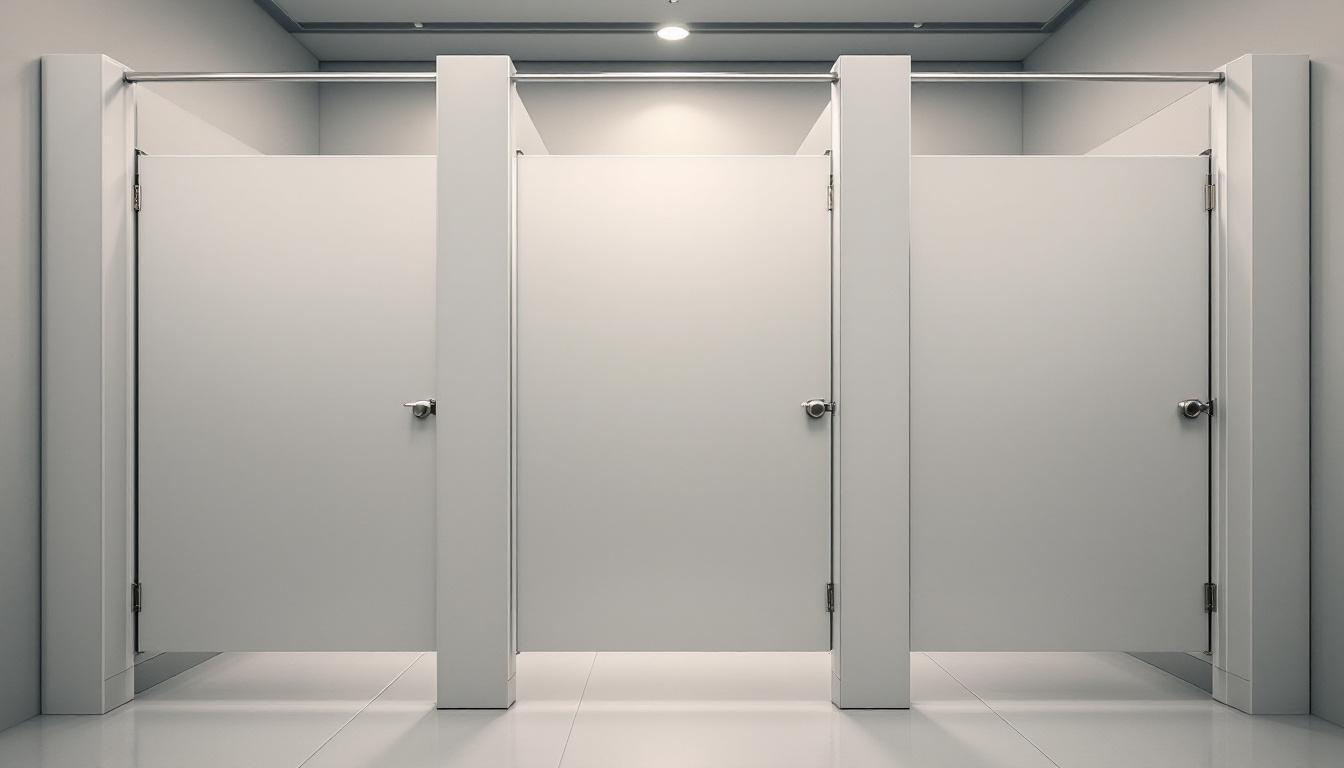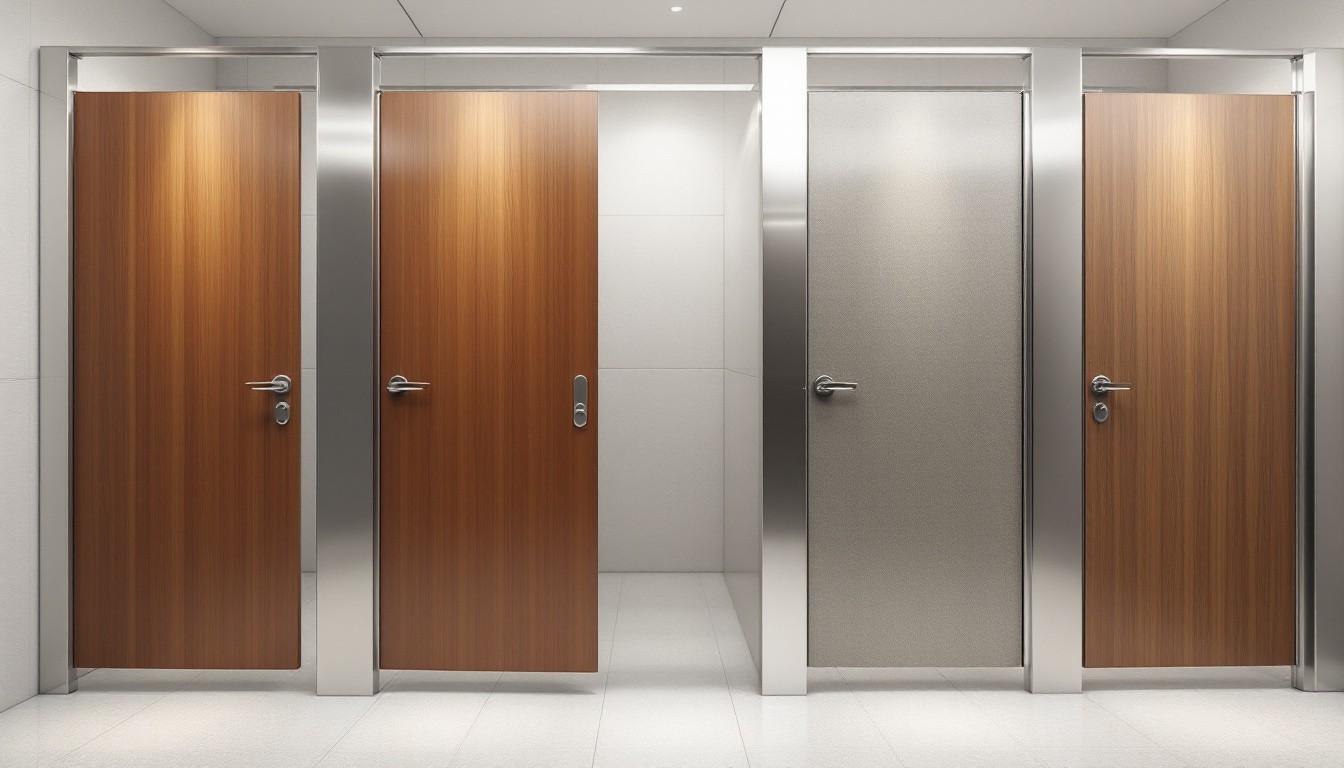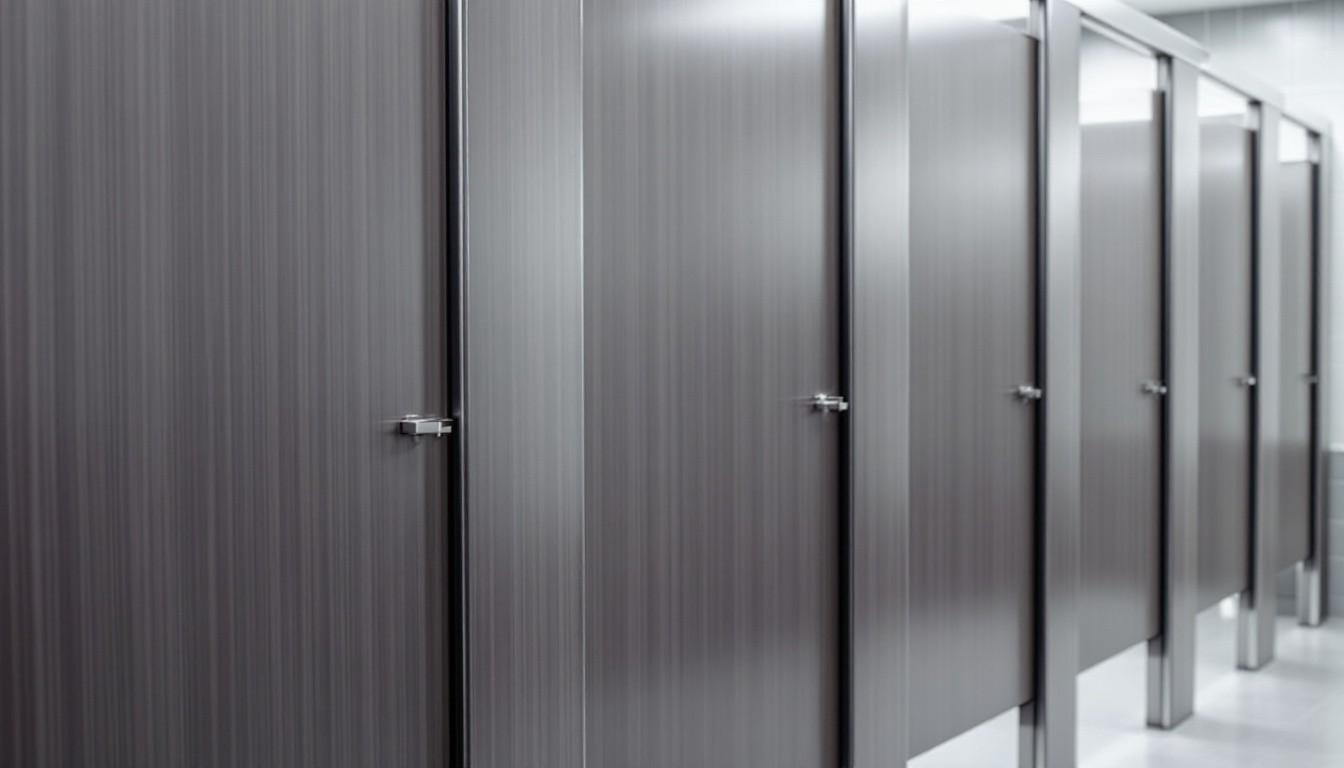Private bathroom stalls are a vital component of any business establishment. They provide comfort, privacy, and a sense of security for your customers and employees.
At Partition Stalls, we understand the importance of creating well-designed, functional, and aesthetically pleasing restroom spaces. This guide will walk you through the essential steps to set up private bathroom stalls that meet your business needs and enhance user experience.
What Materials Make the Best Bathroom Stalls?
Stainless Steel: The Gold Standard
Stainless steel excels as a top choice for bathroom stalls. It offers incredible durability, withstands heavy use, and resists corrosion. Stainless steel partitions can last for decades with proper maintenance. They require minimal cleaning-a quick wipe-down with mild detergent maintains their shine.
HDPE: Graffiti-Resistant and Low-Maintenance
High-Density Polyethylene (HDPE) presents another excellent option. Its graffiti-resistant properties make it ideal for high-traffic areas prone to vandalism. HDPE partitions repel moisture, which prevents warping and bacterial growth. Educational institutions often prefer HDPE for its low maintenance requirements and long lifespan.
Powder-Coated Steel: Budget-Friendly Beauty
Businesses with tighter budgets should consider powder-coated steel. It strikes a good balance between durability and affordability. While it doesn’t last as long as stainless steel, it still provides good value. Powder-coated steel comes in a wide range of colors (allowing easy matching with business decor).
Phenolic: The Luxury Choice
Upscale establishments benefit from phenolic partitions. These offer a premium look and feel while resisting impacts, chemicals, and moisture. Phenolic partitions can mimic the appearance of wood or stone, adding elegance to your restroom.
Choosing the Right Material
Your business type, budget, and aesthetic preferences should guide your material selection. High-traffic areas benefit from the durability of stainless steel or HDPE, while a high-end restaurant might opt for the luxurious look of phenolic partitions.
Factor in long-term costs when making your decision. Some materials (like stainless steel) have a higher upfront cost but prove more cost-effective over time due to their longevity and low maintenance needs.
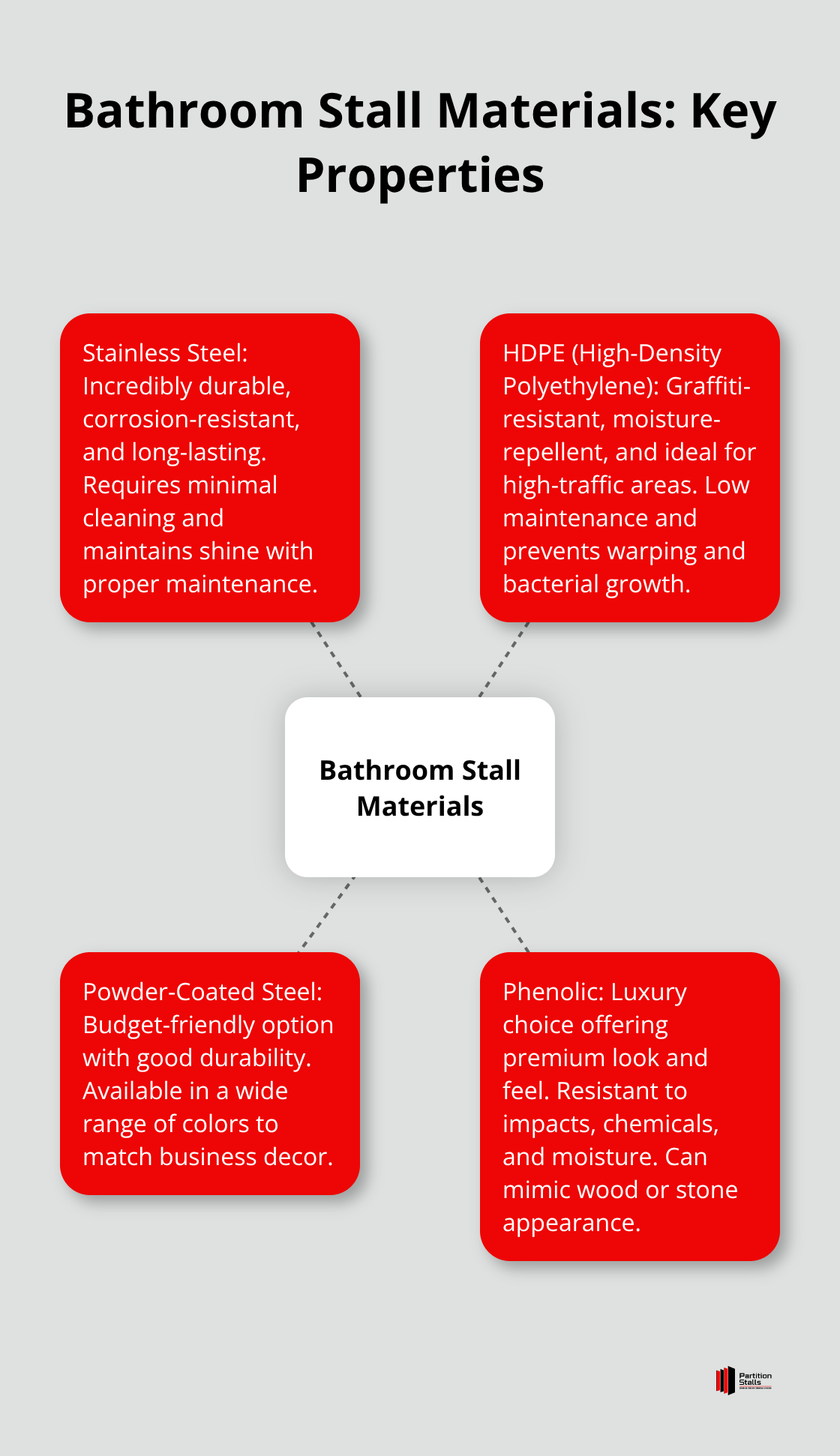
Don’t Forget the Hardware
Quality hinges, locks, and brackets contribute significantly to the overall durability and functionality of your bathroom stalls. Try stainless steel or brass hardware for the best performance and longevity.
Now that we’ve covered materials, let’s explore how to design your stalls for maximum privacy.
How to Maximize Privacy in Bathroom Stalls
Optimal Stall Dimensions
The size of your bathroom stalls significantly impacts user privacy and comfort. The ADA Standards require that unisex toilet rooms, where provided, have privacy latches and contain at most one lavatory, one water closet, and one urinal. However, we recommend larger dimensions for enhanced privacy. Try to create stalls that are at least 42 inches wide and 72 inches deep. This extra space provides a more comfortable experience and reduces the chance of accidental contact with partition walls.
For accessible stalls, the Americans with Disabilities Act (ADA) requires a minimum of 60 inches wide by 59 inches deep. We suggest exceeding these requirements with dimensions of 66 inches wide by 72 inches deep. This ensures ample space for wheelchair users and those who may need assistance.
Eliminating Sight Lines
One of the most common privacy concerns in public restrooms involves gaps between doors and partitions. To address this issue, we recommend several gap reduction techniques:
- Use continuous brackets: These cover the entire edge of the partition, eliminating spaces typically found with standard brackets.
- Install overlapping doors: Having the door overlap the pilaster effectively eliminates the gap on the latch side.
- Add privacy strips: You can retrofit these to existing stalls, covering gaps between doors and pilasters.
- Choose floor-to-ceiling partitions: While more expensive, these provide maximum privacy by eliminating gaps above and below the stall.
Sound Insulation Strategies
Acoustic privacy often gets overlooked but remains equally important. Here are some effective strategies to reduce sound transmission:
- Use solid core materials: Partitions made from solid plastic or phenolic materials offer better sound insulation than hollow-core options.
- Install sound-dampening strips: Add these to the edges of doors and partitions to reduce noise leakage.
- Consider ceiling baffles: In open-ceiling restrooms, install acoustic baffles to help absorb and diffuse sound.
- Add background noise: A low level of ambient sound (like soft music or white noise) can actually increase perceived privacy by masking specific noises.
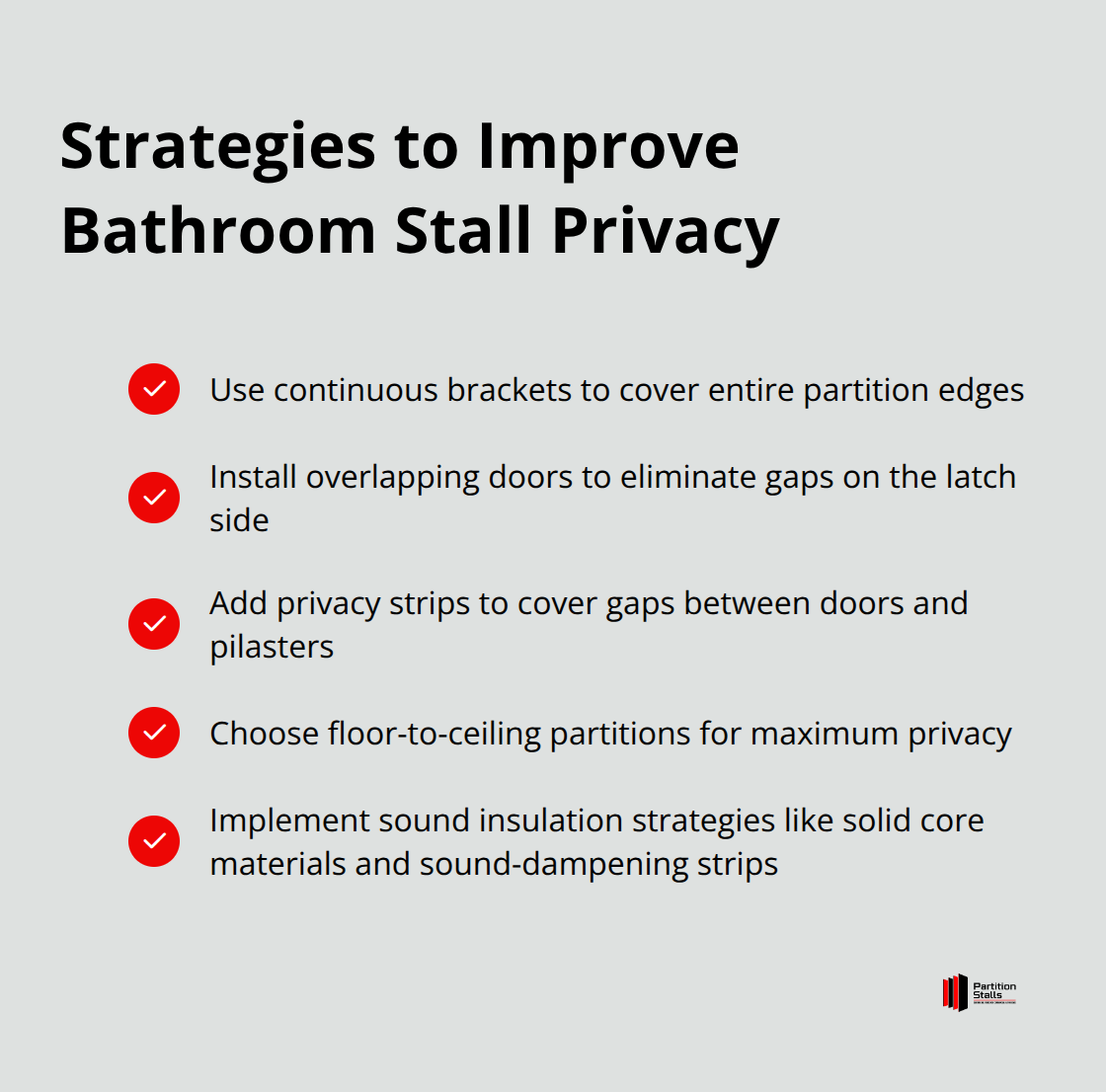
Material Selection for Privacy
The choice of materials for your bathroom stalls can significantly impact privacy levels. Solid materials like High-Density Polyethylene (HDPE) or phenolic resin not only provide durability but also offer superior sound insulation compared to hollow-core alternatives. (These materials also resist graffiti and are easy to clean, making them ideal for high-traffic areas.)
Privacy-Enhancing Hardware
Don’t overlook the role of hardware in creating private bathroom stalls. Self-closing hinges prevent doors from staying open, while high-quality locks (with occupancy indicators) give users peace of mind. Consider installing coat hooks and shelves inside each stall to keep personal belongings off the floor and out of sight.
Now that we’ve covered how to maximize privacy in bathroom stalls, let’s explore the best practices for installation and maintenance to ensure your private stalls remain in top condition for years to come.
How to Install and Maintain Your Bathroom Stalls
Professional Installation vs. DIY
Professional installation of bathroom stalls yields optimal results. Experts ensure proper alignment, secure fastening, and compliance with local building codes. The installation process typically takes 1-2 days, depending on the restroom size and stall quantity. High-quality hardware is essential; stainless steel screws and bolts resist corrosion and provide long-lasting stability. Gravity hinges are an excellent choice for doors, as they automatically close, enhancing privacy.
Bathroom stalls are generally easy to install. With the right tools and clear instructions, most partitions can be set up without major difficulties. However, DIY installation can lead to safety hazards and reduced stall longevity. Those who choose this route should follow manufacturer instructions meticulously and consider professional consultation for guidance.
Effective Cleaning Routines
Regular cleaning maintains hygienic and visually appealing bathroom stalls. Implement a cleaning schedule that includes:
- Using enzyme-based cleaners to break down urine proteins
- Scrubbing grout lines to prevent buildup
- Ensuring adequate ventilation
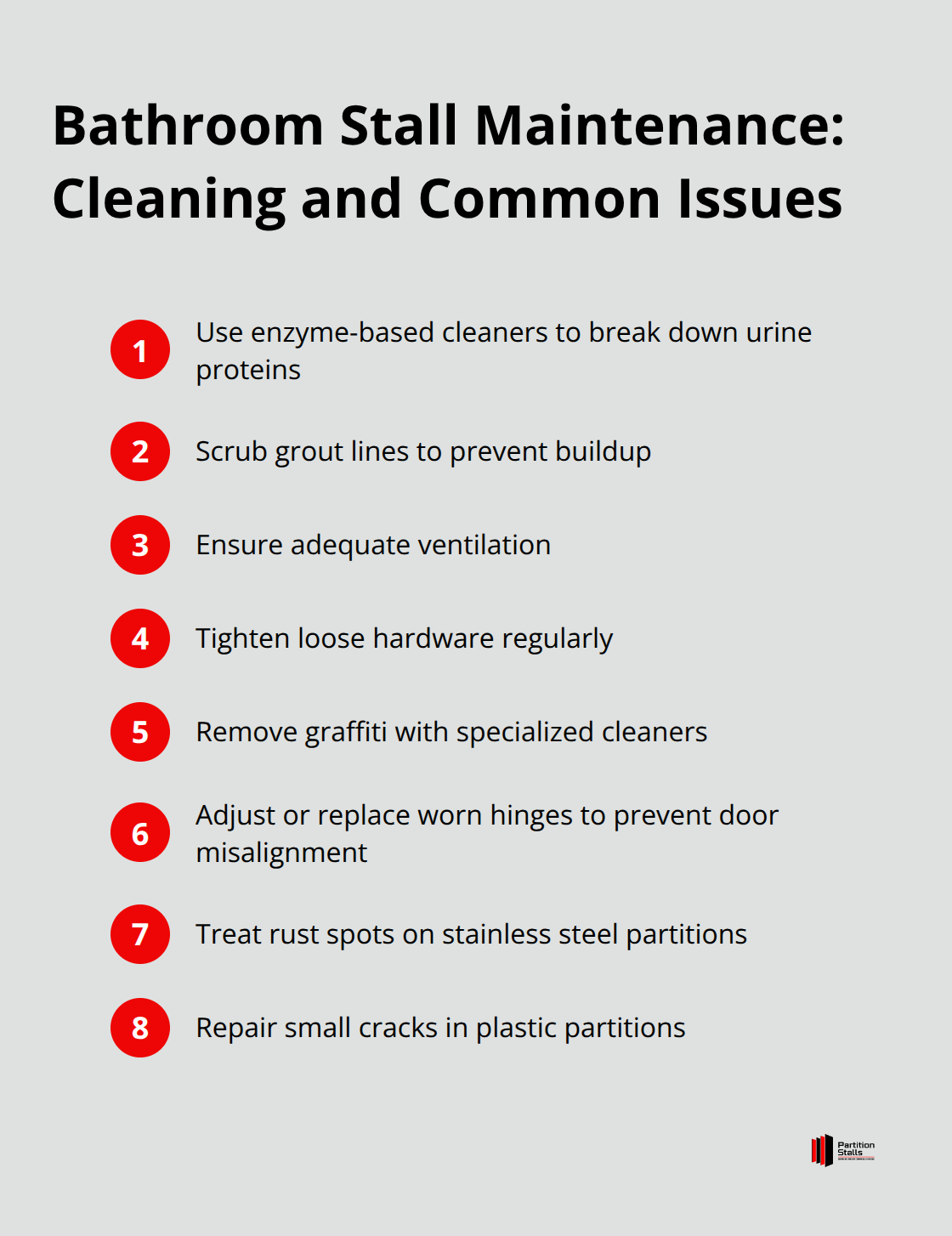
For deeper cleaning, use a pressure washer on stainless steel or HDPE partitions weekly. This removes stubborn stains and buildup. Avoid abrasive cleaners or steel wool, as these can damage partition surfaces.
Tackling Common Wear and Tear
Bathroom stalls experience wear over time. Common issues and solutions include:
Loose hardware: Tighten screws and bolts regularly. Replace any that show corrosion signs.
Graffiti: Use a specialized graffiti remover for non-porous surfaces like HDPE. On other materials, a baking soda and water mixture can be effective.
Door misalignment: Adjust or replace worn hinges. This prevents gaps and ensures proper closure.
Rust spots: Use a rust remover designed for stainless steel partitions. Follow up with a stainless steel polish to restore shine.
Partition cracks: Repair small cracks in plastic partitions with a two-part epoxy. Replace the affected panel for larger damages.
Preventive Maintenance
Conduct regular inspections (at least monthly) to catch problems early. This approach prevents minor issues from becoming serious and costly repairs. Well-maintained bathroom stalls not only look better but also provide a more hygienic and comfortable experience for users (positively impacting customer perceptions and employee satisfaction).
Upgrading and Replacing Components
Try to upgrade components periodically to maintain stall quality. Replace worn-out locks, hinges, or panels as needed. Consider new technologies or materials that can enhance privacy, durability, or ease of maintenance (such as self-cleaning surfaces or improved locking mechanisms).
Assess durability and maintenance needs when selecting materials for your restroom stalls. The longevity of your restroom stalls depends on the materials used and the level of maintenance they require.
Final Thoughts
Private bathroom stalls enhance customer satisfaction and employee comfort. Quality materials like stainless steel or HDPE ensure durability and easy maintenance. Optimal stall dimensions, gap reduction techniques, and sound insulation strategies improve user experience and privacy.
Professional installation and regular maintenance keep bathroom stalls in top condition for years. Well-designed restrooms reflect positively on your business image and set you apart from competitors. They also boost employee morale and productivity (a win-win for any business).
To upgrade your facilities, assess your current restrooms and prioritize changes based on budget and needs. Partition Stalls offers comprehensive restroom solutions designed for various commercial spaces. We can help you create private bathroom stalls that elevate the overall experience for everyone who uses your facilities.


